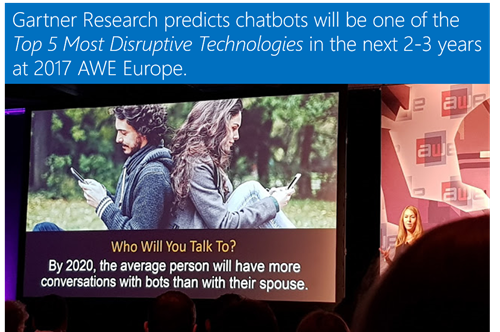Customer care AI chatbots like website chat windows and interactive phone system auto attendants have become mainstream solutions for transforming the customer experience. However, implementing chatbots for internal use is a growing trend in comprehensive digital strategies that strive to enable a modern business culture of agility, creativity and innovation. Corporates investing in these internal chatbots are betting on them as a major asset in empowering employees and here are a few reasons why.
Chatbots Leverage Existing Workflows and Infrastructure
Most companies can already boast a well-embraced suite of enterprise communication products and when used properly, chatbots serve to supplement and enhance these existing communication channels. Appropriately deploying AI chatbots to systems you already use to engage and empower employees such as Skype for Business and Microsoft Teams, allows employees to leverage AI from within those existing authenticated enterprise applications. This saves employees the time and frustration of switching between applications and eliminates the learning curve that typically comes with a new tool.
Eliminating daily app fatigue- switching context between apps many times to get specific tasks done- or the need for additional app downloads, installations or extra logins ensures your employees can focus on tasks that engage your customers and generate revenue. Introducing chatbots within the single, self-service window of an existing tool also strengthens employee mobility. Using the same platforms they are already familiar with, they can now leverage AI for round the clock services without waiting for human assistance, no matter where they are or when they need it.
Chatbots Leverage Existing User Experience Interfaces

The text and speech based language capabilities of modern AI chatbot applications like Siri, Cortana and Alexa are continually evolving and your employees are already accustomed to these and other natural language interfaces through their own consumer relationships. Therefore there is no need to reinvent the wheel with respect to the employee experience when interacting with chatbot technology. Chatbot design is minimalistic without many graphical widgets to help employees engage in productive conversations and get their job done easier, faster and in a more intuitive way. Hiding the chatbot's heavy lifting with a clean and clear conversational user interface (UI) projects the illusion of a simplified workflow with little to no onboarding instructions.
Chatbots Are Supported by Key Stakeholder Initiatives

Multiple business units must come together using the same guiding principles and initiatives they are likely already working on within your organization to build a chatbot solution.
- Marketing- Content management teams can oversee content in your chatbot to test and govern messaging that resonates with your workforce while aligning with your overall brand.
- IT- Chatbots need a well-designed, robust and extensible architecture. Single code solutions to multiple channels are readily available to help your IT team(s) create and support a stable, flexible and secure bot system.
- Leadership- Business leaders from middle management to executives can monitor chatbot usage through a dashboard to detect problems and identify opportunities for growth and personalization. Bot platforms are robust and typically include additional features like, user management, state management, chat logging and telemetry to further support leadership.
- QA- One of the more important benefits of the chatbot is extensive performance and scalability testing. As the audience base increases and shifts with the growth of your business, chatbots are designed to handle a high influx of parallel requests without impacting service capacity or quality.
How to get started with chatbots?

For those jumping on the bandwagon, one of the low hanging fruits is the enterprise FAQ. Today's chatbots can be easily trained to answer predictable, repetitive questions from the corporate knowledge bases. Currently, an employee in search of information may be required to skim through internal databases and file sharing tools like SharePoint and Dynamics CRM, reach out to your IT helpdesk and HR teams or browse your Intranet portal to find what they are looking for. FAQs are an easy place to start for increasing information discoverability and document accessibility to enhance their productivity.
You can then easily build on the success of this initial adoption by moving to more data intensive and cumbersome operations for the bot. Chatbots are best known for their ability to pull from a database of pre-programmed answers however, they can also be used to push necessary action too. Beyond retrieving and disseminating deeply hidden documents, chatbots may be used to send reminders for tasks and scheduled meetings.
Once your bot is effectively helping employees locate information and documents and pushing simple tasks out to your teams, you can then consider transitioning from a simple rule-based bot to an artificially intelligent (AI) bot. This transforms your chatbot capabilities from answering simple questions to a trainable tool that uses Natural Language Processing (NLP) tools like Microsoft's LUIS, to take up more complex queries. Hence, the chatbot is no longer restrained to pre-programmed commands. An AI chatbot is trained to track 'keywords' in the user's request and execute actions accordingly. Tools like Microsoft's Cognitive Service, LUIS, contain several other features to build intelligence into your chatbots such as: speech recognition and conversion, knowledge extraction, and sentiment analysis. In this manner your chatbot can continue to learn and consume data that in turn makes it more intuitive and helpful to your teams for even more optimization and efficiency gains.
Summary
Empowering employees with clear and uncanny channels to help declutter and streamline their workflows allows them to concentrate their energies on fulfilling the primary responsibilities associated with their roles. Chatbots can make real-life impact on processes and workflows that effect operations each day.
- Sales teams can focus on generating leads and pipeline management while a bot takes care of updating them on Sales KPIs.
- ITSM can focus on critical enterprise security issues while a bot caters to office Wi-Fi password requests.
- Employees can focus on their line of business with a bot that automates mundane tasks such as sending a text to request time-off or recording billable hours on a project.
- HR can use chatbots to efficiently onboard newcomers and point them to specific and relevant training material.
Chatbots can be rolled out on a functional or departmental basis through existing communication channels like Skype for Business or Microsoft Teams. These channels support native integration of chatbots into existing business flows so that end-users will feel like the bot is just another person in their workspace. From finding a template to lessening training needs for employees, enterprises will soon witness an exponential surge in the number of use cases for these chatbots.
Next Steps
Your very own branded, 24x7 employee support system that will revolutionize your work culture is an enticing offering. But the successful adoption of any chatbot is driven by the core necessity and validity of the use case the bot is built for.
At Valorem, we understand the transformative impact chatbots can have on your businesses- from creating a great pitstop for your employees to one that will eventually evolve into the mainstream channel for communication within your organization. Our innovative digital specialists can help you BOT'ify your business. Go to valorem.com or email us at sales@valorem.com to learn more.

